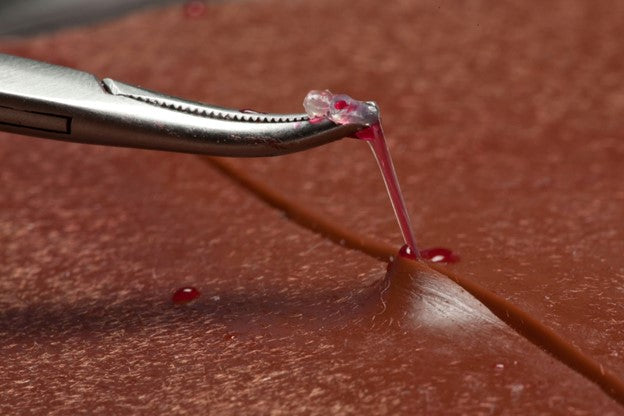
To learn more about our RealFlow Suture Pad click here.
THE IMPORTANCE OF MASTERING LIGATIONS IN SUTURING
Ligatures are an important set of suture skills to master in surgical practice. Ligation of blood vessels are used to occlude bleeding, while pedicle ligations are frequently used in procedures such as ovariohysterectomy and tubal ligation. Using a hemostat to clamp and secure the vessel, then closing off the gap with a suture knot will ensure that homeostasis is achieved in the wound. Learning to properly execute this skill should not be left to the last moment when facing one’s patient on the OR table. The best course of action would be to start practicing vessel ligation early in your medical training.
WATCHING IS NOT ENOUGH - PRACTICE IS NEEDED
Medical students especially in the surgical field are commonly encouraged to closely observe well-established and seasoned practitioners perform surgeries. Watching someone else perform a surgical procedure either through a live demonstration during medical rounds or even just through an online video can afford some degree of learning and appreciation of each case study. However, procedural skills such as deep tissue suturing, ligatures, knot tying and the various techniques taught in textbooks cannot merely be acquired theoretically. One must dedicate enough time each week to mindfully practice the different techniques and imagined scenarios. The physical act of placing the sutures and throwing each knot will be etched in one’s mind much more readily than passively observing from the sidelines.
Professors and medical instructors often talk about how students panic in real life when first exposed to a bleeding event. Imagine facing profusely bleeding patients, with gaping wounds and throbbing arteries, requiring a specific set of stitches to stop the bleeding and reach homeostasis. It is natural to feel nervous, and possibly even panic, if this is the first time ligation techniques are applied by the student. Yet, if this is a procedure that the trainee has done before in a simulative setting, their experience and competence should trump their nerves. In these types of situations, the previously acquired knowledge, muscle memory and technical know-hows will either kick-in and come through to the surface or prove their lack thereof. When the theoretical knowledge and practical skills are learned properly, it will be exemplified in one’s level of confidence and competence.
BENEFITS TO ALL PARTIES
Simulative learning provides ample benefits to students, teachers and patients alike. The students will be able to develop important real-life skills and confidence in an unhurried way, all the while avoiding any ill-faced outcomes on their patients. For professors, the use of simulation-based learning kits is the most convenient, reusable and accessible way to educate their pupils.
THE REALFLOW PAD
In a regular suture pad the reality of blood vessels is completely absent. Yet when living tissue is incised, bleeding will occur. This is one of the most difficult simulative procedures to recreate using DIY or makeshift materials. SurgiReal offers a practice pad that does just that—it realistically replicates live tissue by bleeding in response to an incision. Others have tried to make their own flow pads using sponges and plastic tubes, but the realism and practicality are significantly lacking, not to mention the time and effort put aside to make something that is of one-time use.
REALISM AND REUSABILITY
When it comes to surgical procedures, practice is what makes perfect. The RealFlow pad offered here is carefully constructed with 6-layers of varying types of tissue each designed to mimic the reality of living tissue. This pad is made without latex, which is considered too stretchy and tough as compared to silicone, which much more closely resembles real tissue. Not only will this pad permit students to learn the art of needle placement, for both the superficial and deep sutures, but it will also effectively teach bleeding management. With each incision, a blood-like liquid will flow out. With the use of an IV-bag, the flow of the simulated blood can be adjusted and controlled for even more nuanced learning opportunities. There are actual vessels built into the pad that can be clamped using forceps and then closed off with sutures. The numerous vessels/veins embedded into the suture pad allow for multiple incisions and sutures, thereby increasing its reusability.
Investing in one of these handy suture pads will definitely seem a very small cost when encountering real patients in dire straits, who could really benefit from the experience and confidence gained as a result of prior effort and practice.
To learn more about our RealFlow Suture Pad click here.
